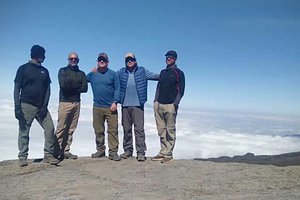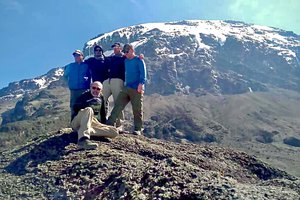Mountain Climbing



MOUNTAIN CLIMBING
Africa offers endless opportunities for highland trekking and mountain climbing, from gentle hikes such as Mount Longonot to trekking the slopes of Mount Kenya, or more demanding hikes - ascending the world famous Mount Kilimanjaro, which rises from the clouds, 5895 meters above the rolling plains of northern Tanzania. It is the highest free-standing mountain in the world. Although there are a number of trails up the mountain, representing different levels of ability and endurance, it is a grueling undertaking, and can be quite a demanding trek. You do not need specialized mountain climbing skills nor mountaineering equipment on this challenging vacation on Africa's highest peak, but you will need the skills of an experienced support team. Apart from the personal triumph of conquering the mountain, there is also the unforgettable trek from summer to winter in a matter of days as you traverse through very different zones that mark your progress from verdant plains, tropical forests, alpine meadows, inhospitable winter scree and glaciated snow fields. To stand above the clouds as the sun rises in a world so inhospitable that you can only bear its wonder for a matter of minutes before being forced to descend from its oxygen-starved heights. In this bizarre habitat, you will find vegetation that grows nowhere else on earth: such as the giant groundsel and senecios, like sentinel columns wrapped in fur or topped by cabbages. Other incredibly aged vegetation has adapted to being regularly uprooted by the cycle of freeze and thaw in its Arctic wastes. You will find a place like you few have ever seen before, and you will face yourself, your limits and a personal discovery you could never have achieved elsewhere on Earth.
On the other hand, Mount Meru is less visited but still a wonderful trekking experience. It is a younger, active volcano with steep cliffs and a central ash cone still showing signs of life. It is home to a wide range of wildlife. Affording fantastic views overlooking Arusha National Park plains below and the algae-rich Momella Lakes, it is a more relaxing introduction to an acclimatized holiday in Tanzania.
Further north lies Ol Doinyo Lengai, otherwise known as the "Mountain of God" to the local Maasai community. The Maasai believe this is a sacred site and also believe that God (Engai) triggers frequent eruptions and droughts. The locals make regular pilgrimages with offerings to appease the Gods and in return seek blessings for their children and livestock, or to beg the favor of fertility. It offers a challenging day-long scramble and should not be undertaken lightly.
Mount Kenya is Africa’s second highest mountain and like Kilimanjaro, it is an extinct volcano. At 5,199 meters high - almost 700 meters shorter than Kilimanjaro, it poses challenges of its own. Only one of its three peaks is accessible without real mountain climbing skills and specialist climbing guides. Mount Kenya actually has three peaks: Batian, Nelion and Point Lenana. Depending on which one you choose to climb, the ascent ranges from a intermediate-level trekking experience to a highly technical rock climb.While many guides offer ascents of all three summits, there are also options to only hike to Point Lenana. Regardless of the summit to which you head on Mount Kenya, you will need a high level of fitness, as there are many steep sections. You’ll also need to hike considerable distances over multiple days and altitude can also make this ascent more difficult. This is where hiring a certified guide is really important, to make sure that you’re not gaining altitude too quickly. Plus, if you do suffer from altitude sickness, you’ll want an experienced guide on hand to help you manage this.
If you chose to tackle Batian or Nelion, it’s essential that you bring the right equipment too, since you cannot complete these climbs without rock climbing gear. There are five main routes (Sirimon, Buruget, Naro Moru, Chogoria & Timau) to reach point Lenana on Mount Kenya. It’s pretty common to combine these and to choose different trails for the ascent and descent. This helps you control the time of your trip and it also means you get to see different scenery and experience the diverse landscapes surrounding the mountain.









